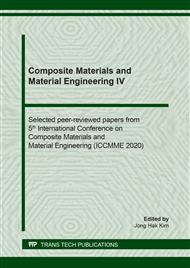[1]
A.O. Ibhadon, P. Fitzpatrick, Heterogeneous photocatalysis: Recent advances and applications, Catalysts. 3 (2013) 189–218.
DOI: 10.3390/catal3010189
Google Scholar
[2]
I. Ganesh, P. Kumar, A. Gupta, P. Sekhar, K. Radha, G. Padmanabham, G. Sundararajan, Preparation and characterization of Fe-doped TiO2 powders for solar light response and photocatalytic applications, Process. Appl. Ceram. 6 (2012) 21–36.
DOI: 10.2298/pac1201021g
Google Scholar
[3]
J. Schneider, M. Matsuoka, M. Takeuchi, J. Zhang, Y. Horiuchi, M. Anpo, D.W. Bahnemann, Understanding TiO2 photocatalysis: Mechanisms and materials, Chem. Rev. 114 (2014) 9919–9986.
DOI: 10.1021/cr5001892
Google Scholar
[4]
G.D. Lakshmipathi Naik, N. Kottam, G.K. Shivashankar, Photo catalytic degradation of azo dyes over Mn 2+ doped TiO 2 catalyst under UV/solar light: An insight to the route of electron transfer in the mixed phase of anatase and rutile, Chinese J. Chem. 28 (2010) 2151–2161.
DOI: 10.1002/cjoc.201090356
Google Scholar
[5]
X. Kang, S. Liu, Z. Dai, Y. He, X. Song, Z. Tan, Titanium dioxide: From engineering to applications, (2019).
Google Scholar
[6]
H. Park, Y. Park, W. Kim, W. Choi, Surface modification of TiO2 photocatalyst for environmental applications, J. Photochem. Photobiol. C Photochem. Rev. 15 (2013) 1–20.
Google Scholar
[7]
Q. Wang, R. Jin, M. Zhang, S. Gao, Solvothermal preparation of Fe-doped TiO2nanotube arrays for enhancement in visible light induced photoelectrochemical performance, J. Alloys Compd. 690 (2017) 139–144.
DOI: 10.1016/j.jallcom.2016.07.281
Google Scholar
[8]
J.C. Te Lin, K. Sopajaree, T. Jitjanesuwan, M.C. Lu, Application of visible light on copper-doped titanium dioxide catalyzing degradation of chlorophenols, Sep. Purif. Technol. 191 (2018) 233–243.
DOI: 10.1016/j.seppur.2017.09.027
Google Scholar
[9]
Z. Zhou, H. Wang, Z. Zou, M. Du, J. Guo, Z. Yang, Investigations on the origin of ferromagnetism of Cu doped anatase TiO2 nanotubes, Mater. Res. Bull. 86 (2017) 287–294.
DOI: 10.1016/j.materresbull.2016.09.034
Google Scholar
[10]
M.C. Nevárez-Martínez, M.P. Kobylanski, P. Mazierski, J. Wółkiewicz, G. Trykowski, A. Malankowska, M. Kozak, P.J. Espinoza-Montero, A. Zaleska-Medynska, Self-Organized TiO2-MnO2 nanotube arrays for efficient photocatalytic degradation of toluene, Molecules. 22 (2017) 564.
DOI: 10.3390/molecules22040564
Google Scholar
[11]
V.D. Binas, K. Sambani, T. Maggos, A. Katsanaki, G. Kiriakidis, Synthesis and photocatalytic activity of Mn-doped TiO 2 nanostructured powders under UV and visible light, Appl. Catal. B Environ. 113–114 (2012) 79–86.
DOI: 10.1016/j.apcatb.2011.11.021
Google Scholar
[12]
M. Manzoor, A. Rafiq, M. Ikram, M. Nafees, S. Ali, Structural, optical, and magnetic study of Ni-doped TiO2 nanoparticles synthesized by sol–gel method, Int. Nano Lett. 8 (2018) 1–8.
DOI: 10.1007/s40089-018-0225-7
Google Scholar
[13]
P. Singla, O.P. Pandey, K. Singh, Study of photocatalytic degradation of environmentally harmful phthalate esters using Ni-doped TiO2 nanoparticles, Int. J. Environ. Sci. Technol. 13 (2016) 849–856.
DOI: 10.1007/s13762-015-0909-8
Google Scholar
[14]
H.L. Hoşgün, M.T.A. Aydın, Synthesis, characterization and photocatalytic activity of boron-doped titanium dioxide nanotubes, J. Mol. Struct. 1180 (2019) 676–682.
DOI: 10.1016/j.molstruc.2018.12.056
Google Scholar
[15]
S. Singh Surah, M. Vishwakarma, R. Kumar, R. Nain, S. Sirohi, G. Kumar, Tuning the electronic band alignment properties of TiO 2 nanotubes by boron doping, Results Phys. 12 (2019) 1725–1731.
DOI: 10.1016/j.rinp.2019.01.081
Google Scholar
[16]
G. Cinelli, F. Cuomo, L. Ambrosone, M. Colella, A. Ceglie, F. Venditti, F. Lopez, Photocatalytic degradation of a model textile dye using Carbon-doped titanium dioxide and visible light, J. Water Process Eng. 20 (2017) 71–77.
DOI: 10.1016/j.jwpe.2017.09.014
Google Scholar
[17]
Z. Jedi-Soltanabadi, M. Ghoranneviss, Z. Ghorannevis, H. Akbari, Anodic growth of Nitrogen-doped Titanium dioxide nanotubes by anodization process of elemental Titanium in ethylene glycol based electrolyte solution with different water contents, Vacuum. 155 (2018) 387–390.
DOI: 10.1016/j.vacuum.2018.06.027
Google Scholar
[18]
N.S. Peighambardoust, S. Khameneh Asl, R. Mohammadpour, S.K. Asl, Band-gap narrowing and electrochemical properties in N-doped and reduced anodic TiO 2 nanotube arrays, Electrochim. Acta. 270 (2018) 245–255.
DOI: 10.1016/j.electacta.2018.03.091
Google Scholar
[19]
M.S. Mahmoud, M.S. Akhtar, I.M.A. Mohamed, R. Hamdan, Y.A. Dakka, N.A.M. Barakat, Demonstrated photons to electron activity of S-doped TiO2 nanofibers as photoanode in the DSSC, Mater. Lett. 225 (2018) 77–81.
DOI: 10.1016/j.matlet.2018.04.108
Google Scholar
[20]
S.A. Bakar, C. Ribeiro, A comparative run for visible-light-driven photocatalytic activity of anionic and cationic S-doped TiO2 photocatalysts: A case study of possible sulfur doping through chemical protocol, J. Mol. Catal. A Chem. 421 (2016) 1–15.
DOI: 10.1016/j.molcata.2016.05.003
Google Scholar
[21]
N. Chauhan, V. Singh, S. Kumar, M. Kumari, K. Sirohi, Synthesis of nitrogen & palladium co-doped mesoporous titanium dioxide nanoparticles via evaporation induced self assembly method and study of their photocatalytic properties, J. Mol. Struct. 1185 (2019) 219–228.
DOI: 10.1016/j.molstruc.2019.02.055
Google Scholar
[22]
M.S. Stan, M.A. Badea, G.G. Pircalabioru, M.C. Chifiriuc, L. Diamandescu, I. Dumitrescu, B. Trica, C. Lambert, A. Dinischiotu, Designing cotton fibers impregnated with photocatalytic graphene oxide/Fe, N-doped TiO 2 particles as prospective industrial self-cleaning and biocompatible textiles, Mater. Sci. Eng. C. 94 (2019) 318–332.
DOI: 10.1016/j.msec.2018.09.046
Google Scholar
[23]
E.C.R. Lopez, V.A.F. Cleofe, R.Y.A. Cañal, K.F.P. Boado, J.V.D. Perez, Highly-Organized One-Dimensional Copper-Doped Titanium Dioxide Nanotubes for Photoelectrocatalytic Degradation of Acid Orange 52, Key Eng. Mater. 801 (2019) 285–291.
DOI: 10.4028/www.scientific.net/kem.801.285
Google Scholar


